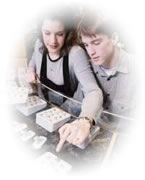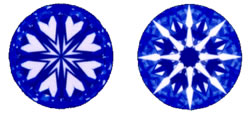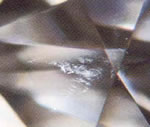WEBSITE HIGHLIGHTS: SELLING YOUR DIAMOND
 The De Beers’ advertising campaign built around the slogan ” A Diamond is Forever” has been very successful in dissuading women from selling the diamonds they have received and discouraging them from buying diamonds which other women have owned. The result is that there is very little secondary market for diamonds compared to the huge retail market for “new” diamonds. There are many reasons why folks need to sell their diamond but all face similar challenges. Selling a diamond is usually an emotional experience so judgment and common sense might be at a low level.
The De Beers’ advertising campaign built around the slogan ” A Diamond is Forever” has been very successful in dissuading women from selling the diamonds they have received and discouraging them from buying diamonds which other women have owned. The result is that there is very little secondary market for diamonds compared to the huge retail market for “new” diamonds. There are many reasons why folks need to sell their diamond but all face similar challenges. Selling a diamond is usually an emotional experience so judgment and common sense might be at a low level.
Our website has a discussion of these challenges and helpful suggestions for selling your diamond.
Learn more about selling diamonds…
DIAMOND SHOPPER MISTAKES: BEWARE OF SALES
 Do not assume a diamond purchase is a great value if the diamond goes on sale, is purchased in the Diamond District in New York or is bought while on vacation out side the country.
Do not assume a diamond purchase is a great value if the diamond goes on sale, is purchased in the Diamond District in New York or is bought while on vacation out side the country.
Jewelry, with the exception of watches, has no list price. Stores frequently mark jewelry up to unrealistically high prices and then give large, though fictitious, discounts. This is why some stores are able to continually run 50% and 70% off “sales.” How much a diamond is marked “on sale” has no relevance to its value. The only thing that matters is what the price is to you for the diamond quality and size you want.
Use common sense. The overhead for these jewelry stores in New York is some of the highest retail rent in the country. Security costs and employee expenses are also high in Manhattan. With high overhead, come prices that are no value. If the price seems low, it simply reflects the low quality they are trying to unload on you. There has been many a consumer who purchased from jewelry stores on 47th Street only to find the diamond they bought was not as advertised when they had it appraised at home. If you thought the high pressure sale people were slick when you purchased, you can only imagine how slippery they will be if you try to get your money back. If you live outside of New York, keep in mind you will have to pay New York sales tax if you purchase there.
Diamonds are traded in the major overseas exchanges in U.S. dollars. Since DeBeers sets the world price on rough diamonds, diamonds will not be less expensive in other countries. Gold also has a set world price, and other gemstones have worldwide markets. Therefore, in general, jewelry will not cost less in foreign countries. There is nothing wrong with spending a small amount of money on a piece of jewelry that will serve as a remembrance of a trip, or on something unusual that may be indigenous to a specific area of the world. However, it is not a good idea to spend thousands of dollars anticipating a “deal.” It is important to shop only where you can assure you are getting the quality advertised. That bargain might prove to be a real waste of money if it turns out not to be what you expected and you have no way to deal with the company located in a different country. Due to the fact that the U.S. market is so competitive, the United States is probably the best place to buy jewelry.
Discover more shopping advice secrets
HEARTS & ARROWS
 Not all ideal cut diamonds are created equal. Diamonds that exhibit a distinct pattern of hearts (viewed from the bottom) and arrows (viewed from the top) are often considered the best of the ideal cut diamonds. To see the Hearts and Arrows pattern, the diamond is viewed through a Hearts and Arrows scope. Of course, once a diamond is set in a mounting it is not possible to examine the hearts from the bottom.
Not all ideal cut diamonds are created equal. Diamonds that exhibit a distinct pattern of hearts (viewed from the bottom) and arrows (viewed from the top) are often considered the best of the ideal cut diamonds. To see the Hearts and Arrows pattern, the diamond is viewed through a Hearts and Arrows scope. Of course, once a diamond is set in a mounting it is not possible to examine the hearts from the bottom.
Not all cutters spend the time to finish the surface with the greatest precision possible. Symmetry is judged on the “neatness” in the shape and placement of facets that yield exact mirror images of opposite features. The hearts must be regular in shape and size. Arrows must appear bold and consistent in length and width. Too short patterns located in the deep middle of the diamond are not as desirable. Patterns must emerge from the outer portion of the diamond and extend to the edge of the stone. Specific facets must be aligned 180 degrees opposite of each other or the hearts and arrows pattern will be incomplete, misaligned, faded or distorted in appearance. If the cut of the diamond is even slightly less than symmetrical, the pattern will be uneven or incomplete.
While it takes approximately one hour to cut the average round brilliant cut diamond, it can take up to four days to cut an ideal cut stone and even longer to finish a hearts and arrows stone because of the precision needed in the symmetry. On average, cutting a hearts and arrows ideal cut stone will require 15% greater waste of the original rough diamond.
With the greater time in cutting, increased diamond waste and the high demand for hearts and arrows diamonds, the result is a premium price. Less than 1% of all diamonds are ideal cut and less than 0.1% display hearts and arrows. Diamonds with the sharp and distinct pattern under the scope will consistently display exceptional fire, scintillation and brightness to the eye. The pattern is an indicator of exceptional symmetry, not its proportions (cut). However, a true hearts and arrows pattern is usually found in AGS 0-cut or AGS 1-cut diamonds.
You must expect to pay more for the rarity, the perfection and time investment of a H&A. The ideal cut diamond with a complete and detailed H&A pattern is approximately 5-10% higher than for an ideal cut stone without such a pattern.
Some companies have branded their diamonds and jewelry lines around the Heart & Arrows concept. There are probably a dozen different brand names for diamonds that display this pattern. These diamonds are not cut any differently than any other H&A diamond; they just have an expensive marketing campaign developed to make you think they are. The knowledgeable shopper seeks out sources of H&A diamonds without the expense of the brand names. Someone has to pay for all those magazine ads, billboards and other marketing gimmicks. Just let it be someone else. Put your money toward the diamond, not the marketing.
Can a round diamond be beautiful and not have a “perfect” H&A pattern? Of course it can. If fact, some of the most beautiful and best values in diamonds are those that have a “nice” but not necessarily “perfect” H&A pattern and therefore don’t have the price premium either.
CERTIFICATION COMPARISON
There are three main certification laboratories for grading diamonds in the United States (AGS, GIA and EGL-USA) that are actively traded on the wholesale market and a second tier of document producers (IGI, NGL, GGL, etc.) that prepare paperwork for mall jewelry store chains and eBay retailers. It is well known in the industry that the second tier document providers are generally one or more color and clarity grades off from GIA standards and almost always in favor of the retailer, not the consumer.
 The more challenging question is how the top three grading laboratories comparing in their accuracy and consistency. We generally only recommend diamonds with GIA or AGS certifications because we find them the most accurate. We find the EGL-USA tends to be too generous with their color grading. There is also a nationwide bias against the EGL-USA amongst appraisers who almost always graduates of GIA training programs. We found that appraisers would start saying negative things about the diamond as soon as they saw the EGL-USA certification, even before they examined the diamond. After loosing numerous sales due to the appraisers negative comments about the EGL-USA even though the diamond was exactly as advertised, we decided the better strategy for our clients and for our business was to focus on GIA and AGS certifications.
The more challenging question is how the top three grading laboratories comparing in their accuracy and consistency. We generally only recommend diamonds with GIA or AGS certifications because we find them the most accurate. We find the EGL-USA tends to be too generous with their color grading. There is also a nationwide bias against the EGL-USA amongst appraisers who almost always graduates of GIA training programs. We found that appraisers would start saying negative things about the diamond as soon as they saw the EGL-USA certification, even before they examined the diamond. After loosing numerous sales due to the appraisers negative comments about the EGL-USA even though the diamond was exactly as advertised, we decided the better strategy for our clients and for our business was to focus on GIA and AGS certifications.
Last year a study was conducted where the same diamonds were sent to the AGS, GIA and EGL-USA laboratories, without the knowledge of the laboratories. The results of the study confirmed our experience with the three certification laboratories. Here are some of the findings of the study.
- The AGS is the strictest grader overall. The EGL is actually stricter in clarity grading than the GIA.
- The EGL is generally softer in color grading than the GIA or AGS.
- Because most diamonds sent to the AGS tend to be triple ideal cut which are highly sought after, the wholesale price of AGS certified diamonds tends to be higher than GIA certified diamonds. The EGL-USA certified diamonds are lower in wholesale price due to their softer color grading.
- The GIA charges more for the certification than other labs, takes longer to grade a diamond than other labs and provides the least useful cut information of the labs. The reasons help explain why diamonds are sent to the other labs.
- Diamond grading is an art, not an exact science. Diamonds send to the different labs can get different ratings for color, clarity, polish, symmetry, fluorescence and even different measurements. The difference in grading can even occur when the same diamond is sent to the same laboratory more than once. While a certification from one of these top labs is an important step in ensuring the quality of your diamond, the paperwork alone does not guarantee the accuracy.
Learn more about diamond certifications…
INCLUSIONS & BLEMISHES: CLOUDS
Cloud inclusions consists of many tightly grouped tiny inclusions, usually pinpoints. The pinpoints might be too small to distinguish individually at 10X, but together they look like wispy white or gray patches. Some clouds look like a light haze, while others are dense and almost impossible to see through.
 The cloud type of inclusion should not be confused with a “cloudy” or “hazy” diamonds. While a very large number of clouds can impact the brilliance of a diamond, the hazy diamond is most often the result of heat on the surface. The heat could have been from a house fire, the setter’s incorrect use of a torch or some other extreme heat that has produced a glaze on the surface of the diamond.
The cloud type of inclusion should not be confused with a “cloudy” or “hazy” diamonds. While a very large number of clouds can impact the brilliance of a diamond, the hazy diamond is most often the result of heat on the surface. The heat could have been from a house fire, the setter’s incorrect use of a torch or some other extreme heat that has produced a glaze on the surface of the diamond.
A common comment on certifications is “Clouds Not Shown” because a cloud drawn on a plot map (indicated by line surrounding the area of the cloud) tends to look much worse than the cloud does under the microscope and would scare shoppers from buying that diamond. Clouds are generally only a problem on SI1 and lower clarity’s if no other inclusion is marked on the plot, i.e. the cloud is the grade maker. On VS2 clarity and higher, clouds are usually very difficult to find even with the microscope.
A big cloud may dull the diamond but clouds are usually one of the “good” types of inclusions in that they are generally white, wispy and difficult if not impossible to see with the eye.
DIAMOND AND JEWELRY TRADE SHOW
The first weekend of June is the date of the largest diamond and jewelry trade show in the country. Thousands of diamond suppliers, colored gemstone suppliers and jewelry designers from all over the world bring their best products to Las Vegas to market to retailers.
This is always a great opportunity for our clients who are seeking exceptional jewelry items or colored gemstones. Every year we take our client shopping list to this trade show and are able to find the best of the best in the world for unique jewelry items, breathtaking colored gemstones or other hard to find items.
If you need a special gift, give us a call today so we can start researching now and add your requests and requirements to our shopping list. It is a once a year chance for us to handpick the most beautiful jewelry items in the world.
GEMSTONES: EMERALD
 Emerald, the green variety of the mineral beryl, is the most famous and favored green gemstone. Its beautiful green color, combined with durability and rarity, make it one of the most valuable gemstones. Beryl also contains other, lesser known gem varieties, such as aquamarine and heliodor. Pure beryl is white; emerald’s green color is caused by chromium impurities (and occasionally by vanadium impurities). Deep green is the most desired color in emeralds. The paler the color of the emerald, the lesser its value. Pale emeralds are not called emeralds, but “green beryl”. They are sometimes heat-treated, in which they become aquamarine.
Emerald, the green variety of the mineral beryl, is the most famous and favored green gemstone. Its beautiful green color, combined with durability and rarity, make it one of the most valuable gemstones. Beryl also contains other, lesser known gem varieties, such as aquamarine and heliodor. Pure beryl is white; emerald’s green color is caused by chromium impurities (and occasionally by vanadium impurities). Deep green is the most desired color in emeralds. The paler the color of the emerald, the lesser its value. Pale emeralds are not called emeralds, but “green beryl”. They are sometimes heat-treated, in which they become aquamarine.
Emeralds are notorious for their flaws. Flawless stones are very uncommon, and are noted for their great value. Some people actually prefer an emerald with very minute flaws over a flawless emerald, as this proves authenticity of the stone. The most common inclusions are slender parallel tubes known as “rain.”
Many emerald flaws can be hidden by treating the emeralds with oil. Newer, more effective fracture-filling techniques are also practiced. Irradiation of some emerald gems is somewhat effective in removing certain flaws.
Emerald may develop internal cracks if banged hard or if subject to extreme temperature change. Emeralds that were treated to mask internal flaws should never be cleaned with an ultrasonic jewelry cleaner, nor should they be washed with soap. These practices will remove the oil and expose the hidden internal flaws.
Emerald is very sensitive to knocks, and the famous emerald cut was developed specifically for this gem to reduce the amount of pressure during cutting.
The finest emeralds are found around Muzo and Chivor in Columbia, where they occur in veins within dark shales and limestones. This source was mined by the ancient indigenous civilizations and was the origin of the large emeralds that came into Europe and Asia during the 16th century, after the Spanish conquest. Before this time Egypt, Asia and Austria supplied the emeralds used by the Romans and in medieval Europe. Few emeralds can match the color of the best Columbian stones, but some fine emeralds are mined in Zimbabwe, Zambia and in Pakistan.
Many centuries ago in the Veda, the ancient sacred writings of Hinduism, there was written down information on the valuable green gemstones and their healing power: “Emeralds promise good luck”, or “The Emerald enhances your well-being”. It does not come as a surprise, then, that the treasure chests of Indian Maharajas and Maharanis contained most wonderful Emeralds. One of the largest Emeralds in the world is the “Mogul Emerald”. It goes back to the year 1695, weighs 217.80 carats and is about 10 cm high. One side is inscribed with prayers, on the other side there are engraved opulent flower ornaments. The legendary Emerald was auctioned off at Christie’s of London for 2.2 million US dollars to an anonymous buyer.
Emerald is the birthstone of May.
